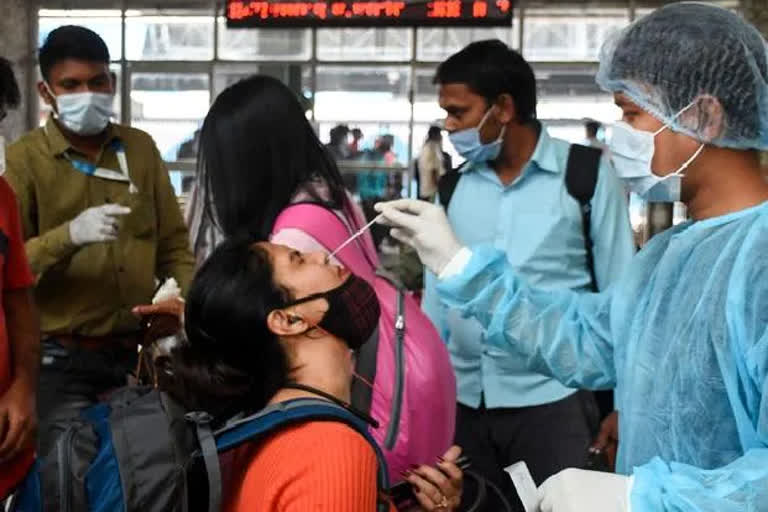New Delhi:India's current R-naught value of 2.69 is much higher than what was recorded during the peak of the pandemic's second wave, the government said on Wednesday.
R-naught (R0), according to Harvard Global Health Institute, is a value that can be calculated for communicable diseases. It represents, on average, the number of people that a single infected person can be expected to transmit that disease to. In other words, it is a calculation of the average “spreadability” of an infectious disease.
Addressing a press conference here, Indian Council of Medical Research (ICMR) Director-General Dr Balram Bhargava said India was seeing an exponential rise in the number of coronavirus cases, which is believed to be driven by its Omicron variant.
He highlighted that the country’s R-naught value is 2.69, higher than the 1.69 recorded during the peak of the pandemic’s second wave.
Addressing a press conference here, Indian Council of Medical Research (ICMR) Director-General Dr Balram Bhargava said the spike in the number of Covid cases is being witnessed in cities and “the Omicron variant is the predominant circulating strain”.
Mass gatherings need to be avoided to lower the speed of the infection spread, he stressed.
“We are now facing an exponential rise in (the number of) COVID-19 cases and we believe that largely, it is being driven by Omicron, particularly so in the western parts of our country and even particularly so in larger cities from where we have more data,” NITI Aayog member (Health) Dr V K Paul said.
On December 30, the case positivity rate was 1.1 percent, and the next day, it was 1.3 percent and now, the country is reporting a positivity rate of five percent, he said, adding that similarly, there were 13,000 Covid cases on December 30 and the number went up to 58,000 on Tuesday.
“Clearly, this is an expanding pandemic. The R-naught value is 2.69. This is higher than the 1.69 we saw when the second wave of the pandemic was at its peak. The acceleration of cases is steeper than ever,” Paul said.
He, however, added that the hospitalisation rates are relatively low. It is close to 3.7 percent in Delhi and five percent in Mumbai.
“That is the early input we have. Compared to this, last year and even in 2020, the hospitalisation rate was close to 20 percent,” Paul said.
He said though there is no need to panic, people must be alert, disciplined, and prepared, adding that the country will face this phase of the pandemic as well.
On whether India is witnessing a third Covid wave, Paul said in other countries, it has been seen that just like a steep rise, there was also a steep decline in the number of cases.
“In Denmark, the UK, and South Africa, cases started declining within a month or a month and a half. We cannot say this clearly for our population. How it behaves will depend on past infections, the vaccination status, and our own characteristics and population density. It cannot be extrapolated that just like the cases behaved there within a month, it will happen here also.
“Saying it at this stage that it will go on till which point and for how long will be premature. If any scientific data comes, we will share it. I would not venture into that except to say that like the previous waves, different parts of our nation will be in different stages. It starts in some states and then goes on and on. We are watching the dynamics of the pandemic carefully,” the NITI Aayog member added.
As regards Omicron, officials said while there has been a sharp rise in the number of cases across the country, the hospitalisation rates have remained relatively low as compared to the previous waves of the pandemic.
Bhargava informed that an Omicron-detecting RT-PCR kit has been developed in a partnership between Tata MD and the ICMR, and it has been approved by the Drugs Controller General of India (DCGI). It will produce the results in four hours and augment the country’s genome-sequencing efforts, he said.
The number of Covid cases is increasing exponentially and quick home testing and rapid-antigen tests will play a major role, Bhargava added.
Joint Secretary in the Union Health Ministry Lav Agarwal said there has been a surge in the number of Covid cases globally, adding that 25.2 lakh cases of the infection were recorded all over the world on January 4, “the highest ever since the onset of the pandemic”.
“India has reported an increase of more than 6.3 times in the number of cases in the last eight days and a sharp increase in the case positivity rate from 0.79 percent on December 29 to 5.03 percent on January 5,” he said.
Agarwal said six states — Maharashtra, West Bengal, Kerala, Delhi, Karnataka, Tamil Nadu — have over 10,000 active Covid cases each.
He further stated that Maharashtra, West Bengal, Delhi, Kerala, Tamil Nadu, Karnataka, Jharkhand and Gujarat are emerging as the states of concern.
Also, 28 districts in the country are reporting a weekly Covid positivity rate of more than 10 percent, while 43 districts are reporting a weekly positivity rate between five percent and 10 percent, Agarwal said.
The Centre said 1.06 crore or 14.3 percent of the beneficiaries in the age group of 15-18 years have been administered the first dose of a Covid vaccine.
There are an estimated 7,40,57,000 beneficiaries in the said age group in the country.
Besides, 90.8 percent of the adults have been administered the first dose of the vaccine, while 65.9 percent are fully vaccinated.
Read:Doctors down with Covid: 218 in Bihar, over 300 in Delhi, Kolkata
